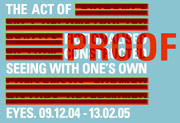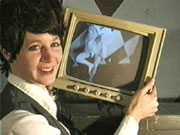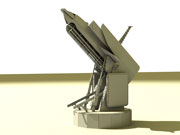PROOF : pictorialised, constructed, the act of seeing with one's own eyes
1 Feb 2005

Curated by Mike Stubbs
09.12.04 - 13.02.05
ACMI Screen Arts Gallery, Melbourne, Australia
Australian Centre for the Moving Image
www.acmi.net.au/proofexhibition.jsp
A review of this exhibit must deal both with the architecture of the Screen Gallery at the Australian Centre for the Moving Image (ACMI) as well as mention the rather uneven articulation of the artworks, some left as gallery pieces or paintings, against their explicit cultures and politics.
PROOF is an ambitious exhibition (22 international artists) drawing together many superb, (rarely seen in Australia) new media and film works across the critical art spectrum. The main thrust of the exhibit, as its title, after Stan Brakhage's film, suggests, is to question the legitimacy of image-making, the eye, the seen and the unseen within parameters of the construction of stories, news, comment, and art. There is, however, additional meaning to this exhibition given the strangely conservative time that new media is facing in Australia amidst otherwise notoriously well-funded arts culture - that is, no funding, or little direct funding, with the eradication of the New Media Arts Board at the top Australia Council levels.

PROOF succeeds in raising the spectre of the political state of new media art, itself, without overtly intending to do so and the Screen Gallery, in the context of PROOF, becomes a space in which one queries the parameters of critical new media and its function in an exhibition space. Does PROOF manage critical work as opposed to being critical? By this I mean that the Screen Gallery, the largest space of its kind in the world(1) and a short walk-in off the street wherein one descends by stair or lift (usually accompanied by installations) into a darkness punctuated by several dozen illuminated screens of all sizes and locations, tends to theme Screen viewing and as such, leaves little room for artists to work with the space. It appears largely predetermined.
Likewise, visitors make the complaint that critical artwork, displayed in this manner, robs it of its vital contexts and dresses it up for the fine art audience like so many paintings. Despite the free entry and the avant-gardism of the architecture, the ambiance of ACMI is one, largely, of an arts management institution. Is politically- charged work, then, and the possibilities inherent in that work, damped down for exhibition? Does the Screen Gallery make display and interaction a function of the institution rather than the art? This is an architectural question.
It was a disappointment to find such excellent political films and documentaries as BIT Plane (1997, Bureau of Inverse Technology) and Dial H-I-S-T-O-R-Y (1997), Johann Grimonprez, for example, projected in a noisy, public installation space where it was difficult to hear. Curiously, the Critical Art Ensemble's own video, Evidence (2004), in which Steve Kurtz's brush with the law is the subject, appeared to have been made as a series of one- liners with the expectation that few would sit through its entirety.

Yet, PROOF's strength is that it seeks to cross over, though not explicitly stated as a theme, aesthetically, with networked cultures and the kinds of socio-critical issues found in the public commons. Australian-made, My Woomera Project (What do you fear?) (2004), by Peter Hennessey, which looks at the Australian refugee crisis in the context of the cultural imagination of Woomera detention centre and its history as a missile-testing ground, was particularly successful in drawing together many related ideas. Ross Gibson's Street X-rays (2004), and New York filmmaker Jem Cohen's 3-screen projection, ChainTimes Three (2004) meditated on the truth of pictures to represent what they do and this, in relation specifically, to place. Cohen's film essay on superstructural utopia/dystopia of the so-called global new economics; the architecture/non-architecture, inhabitation/non- inhabitation of sprawling malls, techparks, multiplex hotels, spiritless poverty and highway infrastructure creeping the globe amidst haunting audio commentary, was particularly alluring and comprehensive. With voiceovers from the lost, walking insane, marginal, and misbegotten, this new work echoes his most wonderful of all films, LOST BOOK FOUND (1997). And, finally, net critic and Latina cultural critic, Coco Fusco's piece Dolores 10 by 10 (2004), which examines the exploitation and surveillance of real Mexican female tech workers, was a pleasure, finally, to see. However, it is felt that this work deserves infinitely larger and more visual attention in the gallery setting so as to force viewers to deal with the truth of the content.

Can, therefore, critical new media and net.art move beyond its own boundaries if future funding is reliant upon institutional support while individual artists funds are cut?
PROOF incidentally stimulates thought on these issues, while retaining its questioning-of-reality theme, but, in truth, the excellence of individual works is what held the exhibit together. One wonders, even, if there wasn't too much work and if we could not have gone deeper. All in all its a good show to see before it leaves.
PROOF catalogue with essays by Mike Stubbs, John Hartley, Steve Kurtz, and Clair Pentecoste on sale at ACMI.
Molly HankwitzLecturer
Queensland University of Technology
Creative Industries Research Applications Centre (CIRAC)
m.hankwitz@qut.edu.au
(1) PROOF program notes, 2005.
◊